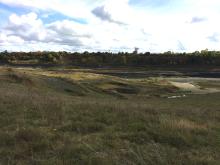
Successful quarry restoration projects in Europe and further afield have been completed by the aggregates industry as Patrick Smith reports
With 23,000 sites across Europe, the aggregates industry is well placed to make a significant, positive contribution to halting the loss of biodiversity.
According to the
Only recently a survey showed that a bird once extinct in the UK has made a remarkable return with quarries providing a safe haven for rare bitterns to nest and breed.
Making use of the bird’s distinctive ‘booming’ call, conservationists found that 2011 was a bumper year for the species. For the first time since 1911, over 100 birds have been found to be nesting in 26 sites throughout England, 15 of them at working or former quarries, a vast improvement on the overall count of just 11 birds recorded in 1996. The minerals industry has had an important role to play in ensuring this success.
“Nature is intrinsically valuable, and studies demonstrate it is fundamentally important to our wellbeing and our economy. But we are losing it at an alarming rate. The mineral products industry is uniquely positioned to step up and help turn this around,” says Darren Moorcroft, head of species and habitats conservation at the RSPB [
“It is fantastic news that all the effort that has been put into restoring quarry sites around the country has provided a home for this rare and unique bird. Catching a glimpse of a bittern as it takes off from a reed bed, and hearing its amazing booming call, are the real rewards for this vital work.”
The
“Our members already manage or control an area of land that adds up in size to a small national park. Given the right recognition and support, we can achieve a great deal more yet.”
In 2006, research conducted by Nature After Minerals concluded that nine out of the 11 priority wildlife habitats listed in the UK government’s former UK Biodiversity Action Plan could be delivered on minerals sites alone.
At its site at Needingworth Quarry in the Fenlands of County Cambridgeshire,
The creation of vital reed bed at this site will help secure the future of breeding bitterns and also that of marsh harriers, snipe, reed buntings, bearded tits, sedge and grasshopper warblers. Water voles, otters, a whole range of plants and insects, and the threatened Desmoulin’s Whorl snail will also stand a better chance of thriving, as a result of the restoration. Such work on minerals sites is being replicated across England by operators large and small.
Indeed, at Natural England’s inaugural Biodiversity Awards (held in conjunction with the MPA 2011 Restoration Awards), Hanson UK was the runner-up for its work at the Kings Dyke Nature Reserve, Peterborough, eastern England, where bitterns were heard booming for the second summer in a row and young were sighted.
Created from 50 hectares of disused brick pits, the reserve project, achieved in partnership with the RSPB, has extensive areas of high quality reed beds linked to the wider Great Fen Project by linear wet grassland. There are also over 30 ponds, several of which hold trans-located populations of the rare bearded stonecrop. The wetlands and grasslands support a range of important and vulnerable plant and animal species including great crested newt and water vole.
The first operator to win the new award was
By 2032, Cemex estimates that it will have created over 200 hectares of the nationally prioritised heathland habitat at Rugeley where priority species already enjoying the new area include nightjar, woodlark, tree pipit, adder and hybrid bilberry.
Cemex voluntarily decided not to quarry sand and gravel to the permitted depth to ensure that the new heathland remained dry.
The company has also worked closely with volunteers from the Friends of Cannock Chase who joined working parties to clear scrub from an area known as Bevin’s Birches to create an open mosaic habitat with lichen heath characteristics.
Since the beginning of operations at the Milaki cement plant 30 years ago,
Some 70,000m³ of soil was spread at the surface level to thicknesses of between 80cm and 1.5m to cover the excavation caused by the quarries’ exploitation.
In the limestone quarry, on benches of 10m high mostly slow-growing trees such as pine trees, acacias, wild olives and cypress trees were planted while in the schist quarry, the slopes were softened to cultivate fruit plants mainly olive trees, almond trees, pear trees and grapevines.
“The rehabilitated area is now covered by a new olive tree farm and a small vineyard in the style of the countryside farms surrounding the quarries,” says Lafarge Greece.
“Nothing indicates now that excavations and quarries were once present in this area.”
More than 200,000 trees and shrubs have been planted in an area of 130 hectares to match the surrounding natural environment and agriculture.
In Tanzania, deforestation and intensive land use are two major problems facing the outlying areas of the major city of Dar es Salaam. For the majority of people, charcoal is the main source of energy in the household, and although the surrounding woodlands have been almost completely denuded, there are no immediate plans for reforestation or recultivation.
In order to encourage sustainable land usage in the areas surrounding the quarries of the
The main purpose of this project is to set up a tree nursery in partnership with external environmental organisations.
“In addition to creating jobs for local people and supplying plant material to rehabilitate the decommissioned quarry, the project will provide young trees to help reforest ravaged areas of woodland in and around Dar es Salaam,” says HeidelbergCement.
“The hope is that a new forest area will provide not only a habitat for endangered fauna and flora but also a welcome retreat for city dwellers and a source of firewood, but only to the extent that this can be replenished by new trees.”







